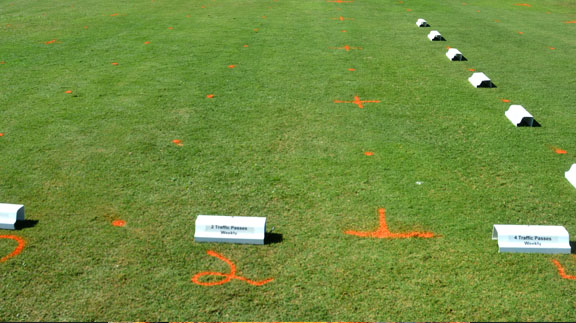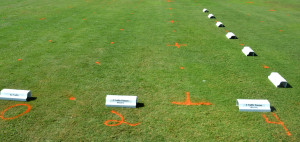Farm & Ranch
[AgriLife Today] Turfgrass researcher works to keep athletic fields green longer

|
By: Kay Ledbetter
Fungicide, nitrogen looked at to reduce wear and tear Writer: Kay Ledbetter, 806-677-5608, [email protected] COLLEGE STATION – Sports fans know as fall sets in and their favorite team heads out on the turf, the bright green grass begins to turn brown from the wear and tear and changing temperatures. 
Nitrogen rate comparisons on turfgrass plots were done by Dr. Ben Wherley, a Texas A&M AgriLife Research turfgrass ecologist.(Texas A&M AgriLife Communications photo by Kay Ledbetter) But a Texas A&M AgriLife Research turfgrass ecologist has completed a study identifying ways to reduce the look of wear and tear from athletic turf traffic. Dr. Ben Wherley, an assistant professor for turfgrass science/ecology with AgriLife Research and the Texas A&M University soil and crop science department in College Station, spent the summer looking at the effects of nitrogen and the fungicide Civitas on foot traffic tolerance on athletic turf. The plots were Tifway Bermuda grass, which is an industry standard for athletic fields in the south, Wherley said. “What we’ve done is traffic these plots with a Brinkman traffic simulator,” he said, adding they did either zero, two or four passes per week through the summer and into the fall. “What we’re trying to do is simulate athletic field traffic that would be equivalent to football.” https://www.youtube.com/watch?v=DNBE4SB6Nqc&feature=youtu.be Past research has shown that two passes per week is equivalent to the amount of stress produced by one NFL football game between the hash marks and the 40-yard line, Wherley said. 
Dr. Ben Wherley, a Texas A&M AgriLife Research turfgrass ecologist, used this Brinkman traffic simulator on his turfgrass plots. (Texas A&M AgriLife Communications photo by Kay Ledbetter) “So looking at these traffic levels of one versus two games a week versus no games a week, what we were trying to determine was the relative effects of nitrogen rate and also a biweekly application of a product known as Civitas, which is labeled as a fungicide but also has been shown to have some other side benefits in terms of various types of stress tolerance.” The application treatment every two weeks included no Civitas, an 8.5 ounces rate of Civitas per thousand square feet and 17 ounces per thousand square feet rate. “So every two weeks through the summer we basically evaluated percent green cover, the amount of green coverage in the plots, also rating the amount of the injury we’re seeing in the plots,” Wherley said. 
Various traffic patterns were compared under treatments of Civitas on turfgrass plots by Dr. Ben Wherley, a Texas A&M AgriLife Research turfgrass ecologist.(Texas A&M AgriLife Communications photo by Kay Ledbetter) “Particularly we were interested as we got into the later fall months when temperatures cooled, daylight or solar radiation was lower and Bermuda grass started going dormant to see whether Civitas could prolong the green cover in the plots,” he said. “Representative of a football field getting into the late fall, we wanted to know if this might be used as an alternative to overseeding because of the benefits of the fungicide combined with pigment in this product.” He said the results showed improvement in green turf cover and color from the Civitas application across all treatments of traffic, “but we had mixed results in terms of improved resistance to or recovery from injury with Civitas.” Wherley said it was also interesting to note that there wasn’t a big difference between the low applications of nitrogen, a quarter pound per growing month, and the high, typically 1 pound per growing month. “This is probably a result of the fact that the soils in our plots have a good amount of inherent organic matter and fertility in them,” he said. “The site is an old dairy farm pasture. So what this tells the turf manager is if you have good levels of soil organic matter, there may not be as high of a nitrogen requirement on your turf.” Wherley said they learned more about the use of Civitas for athletic turf and hopefully through additional testing, will have a good recommendation in the future. -30-
Find more stories, photos, videos and audio at http://today.agrilife.org |
Farm & Ranch
Hazards of Backyard Poultry

By Barry Whitworth, DVM
Having backyard poultry is a popular agriculture enterprise. According to the United States Department of Agriculture, 0.8 percent of all households in the United States have chickens. People keep chickens for a variety of reasons with table eggs being one of the more common reasons.
Unfortunately, some of these poultry producers are not aware of the hazards that come with keeping poultry because many times they carry pathogens but appear healthy.
Chickens are carriers of several zoonotic diseases. These are diseases that can be passed from animals to humans. According to a recent survey in Pennsylvania, a majority of backyard poultry producers were aware of the dangers of avian influenza. However, this study also revealed that far fewer producers were aware of the risk of possible exposure to Salmonella and Campylobacter.
The lack of knowledge about the hazards of raising poultry likely contributes to the continued issues of Salmonella outbreaks associated with backyard poultry. In 2023, the Centers for Disease Control and Prevention reported 1,072 illnesses of Salmonella linked to backyard poultry, and 272 of those patients required hospitalization. Oklahoma reported 43 individuals with the disease.
To read more, pick up a copy of the April issue of NTFR magazine. To subscribe by mail, call 940-872-5922.
Farm & Ranch
Ag Elsewhere: Wyoming

By Tressa Lawrence
Babies are tucked away in every nook and cranny. Many ranchers across Wyoming have baby animals popping up all over this time of year.
Farm & Ranch
Ag Elsewhere: Montana

By Lindsey Monk
Another load of grain in to keep feeding the calves until the green grass can really start popping.
-

 Country Lifestyles1 year ago
Country Lifestyles1 year agoScott & Stacey Schumacher: A Growth Mindset
-

 Equine7 months ago
Equine7 months agoThe Will to Win
-

 Country Lifestyles7 years ago
Country Lifestyles7 years agoStyle Your Profile – What your style cowboy hat says about you and new trends in 2017
-

 Country Lifestyles4 years ago
Country Lifestyles4 years agoAmber Crawford, Breakaway Roper
-

 HOME7 years ago
HOME7 years agoGrazing North Texas – Wilman Lovegrass
-

 Country Lifestyles7 years ago
Country Lifestyles7 years agoDecember 2016 Profile, Rusty Riddle – The Riddle Way
-

 Country Lifestyles8 years ago
Country Lifestyles8 years agoJune 2016 Profile – The man behind the mic: Bob Tallman
-

 Outdoor9 years ago
Outdoor9 years agoButtercup or Primrose?






